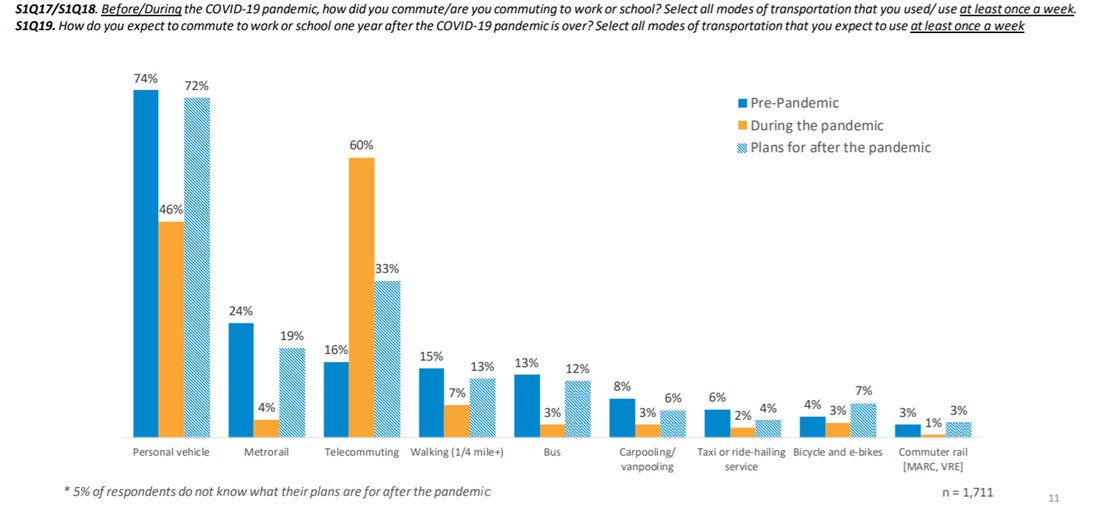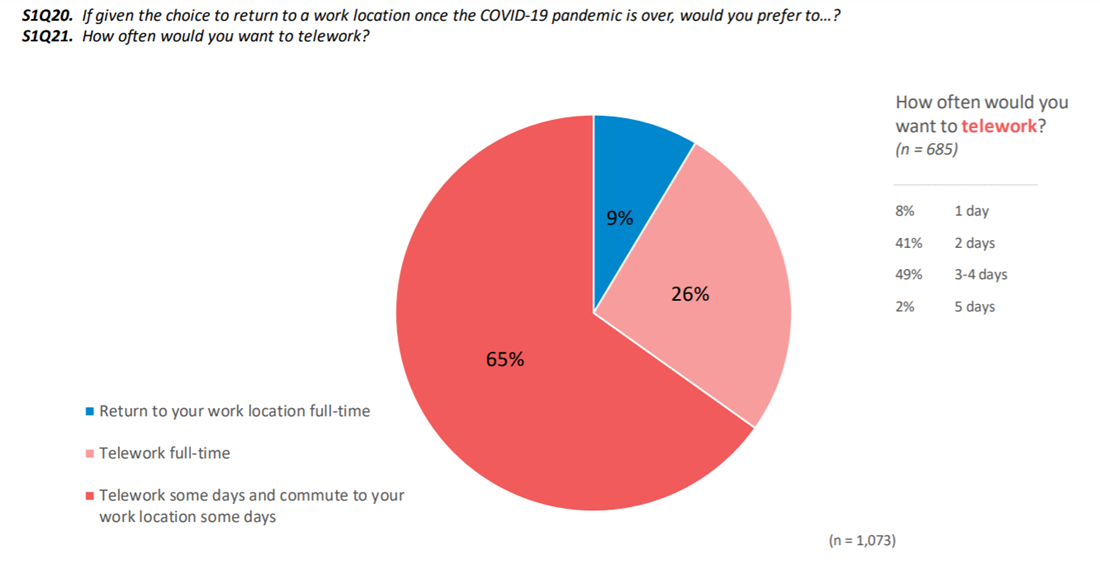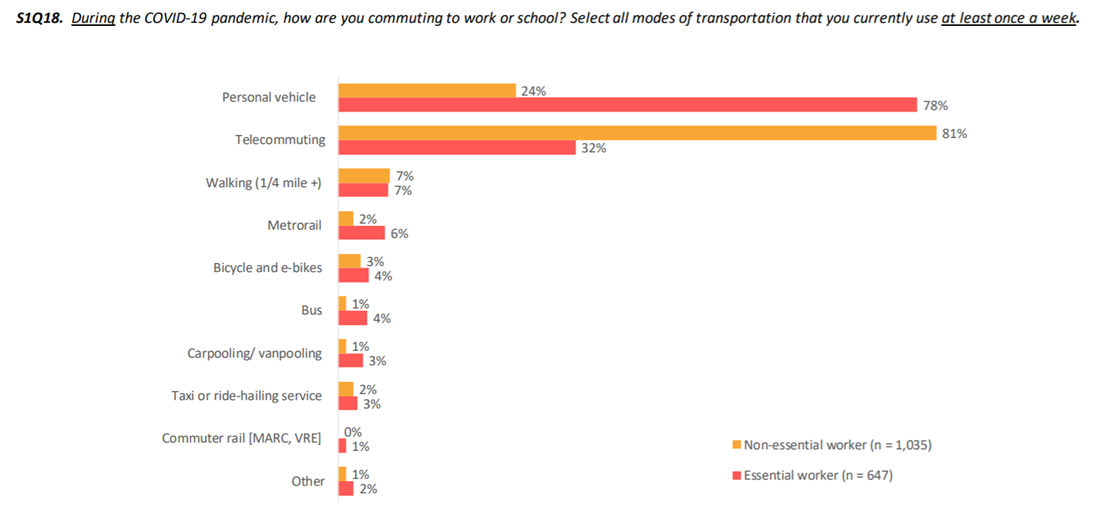Residents of the region have spoken! In the TPB’s Voices of the Region survey, part of the update to Visualize 2045, we asked how people have changed their travel habits due to COVID-19 and how they imagine they will get around post pandemic. Here’s what they had to say.
One year post-pandemic, people expect to walk and bike more
Considering their travel habits during the pandemic, 50 percent of respondents reported walking more and 17 percent reported biking more than they did before COVID-19. These changes appear to be more than temporary as 38 percent of respondents expect to have different travel habits than before the pandemic.
For those who expect to have different travel habits than before COVID-19, 53 percent of people surveyed expect to walk more after the pandemic, while 26% expect to bike more.
While results show momentum for more walking and biking, the survey results also show that people want to see transportation improvements that will help them make these travel habits more permanent in the future.
So, what would make people want to bike and walk more?
When it comes to biking, 34 percent of respondents said they would be more likely to ride a bike if bicycle lanes and routes were more direct and complete. Thirty-two percent would be more likely to use a bicycle if bike lanes were separated from vehicles by a barrier, and 31 percent would be more likely if there were bike lane or trails near their homes.
When it comes to walking, 75 percent of respondents said that they would continue to support the use of street space that has become available for pedestrian access during COVID-19. To supplement this, 63 percent of respondents said that they would like to see more or wider sidewalks.

Source: TPB Voices of the Region Survey
Ninety-one percent of those currently teleworking want to do it in the future
COVID-19 also brought significant changes to the number of people teleworking. The survey results show that the percentage of people working from home at least part time went from 16 percent pre-pandemic to 60 percent during the pandemic.
A large majority (91 percent) of the respondents currently working from home said that they want to continue working from home one year after the pandemic. Of those current teleworkers, 26 percent said they want to work from home full time and 65 percent said they want to work from home part time.
However, COVID-19 is clearly not the only factor promoting interest in telework, which was demonstrated in the answers to the survey’s open-ended question, “What transportation investments should we make today that future generations will thank us for tomorrow?” Responses show there are reasons beyond the pandemic that people want to work from home. Some said they want to make working from home more accessible to reduce traffic congestion, while others mentioned their impacts on climate change.

Source: TPB Voices of the Region Survey
What about essential workers? How are their travel habits affected?
During COVID-19, public officials have encouraged employers to allow their employees to work from home, but there are many jobs that cannot be done from home. These include essential jobs like those in health care, food service, construction, and many others.
The survey acknowledged this difference by asking explicit questions about essential worker status and the need to leave home for work. One question asked respondents who were currently employed whether they needed to travel outside their homes during the pandemic to economically support themselves or their family. Another question asked respondents if they are considered essential workers who are required to travel outside their homes for a job in specific industries.
Forty-three percent of respondents who work full or part-time said they needed to travel outside their homes during the pandemic to economically support themselves or their families. Low-income respondents were significantly more likely to fall into this group.
The majority of respondents with low-incomes declared themselves as having to travel outside the home to economically support themselves. Only 21 percent of respondents with low-income said that they teleworked during the pandemic in contrast to 62 percent of higher-income individuals who reported teleworking during this time.
People who identified themselves as essential workers were significantly more likely to drive alone to work, carpool/vanpool, and use Metrorail relative to non-essential workers. And people working outside the home due to economic necessity used these modes in even greater numbers.
These results confirm that while there is momentum for teleworking, there are still people who are unable to telework and will continue to be dependent on public transportation and driving. The region will need to continue working to provide safe and reliable transportation options for these people during COVID-19 and afterwards.

Source: TPB Voices of the Region Survey
Public transportation continues to be important as we move to recovery
Public transportation continues to be an important choice for many people. And while public transportation has seen a decline in ridership during COVID-19, people are expecting and wanting to get back on transit one year post-pandemic.
When asked how they were expecting to commute one-year after the pandemic, 19 percent of respondents said that they expect to use Metrorail and 12 percent said that they would use the bus. These are slight decreases from 24 percent of people reporting using Metrorail and 13 percent using the bus before the pandemic.
However, respondents encouraged public transportation officials to continue implementing safety precautions to continue making them feel safe while using public transportation during COVID-19 and afterwards.
Of people who reported being frequent public transportation users, 53 percent said that more frequent cleaning of buses and trains would make them more likely to use transit. Fifty-one percent would be more likely use to transit if there were more spacing between people on buses and trains, and 44 percent would be more likely to use it if service were more frequent. Many transportation agencies are already acting to implement these improvements, and these survey responses provide confirmation of their importance with the public.
The qualitive results from the survey through the open-ended question show that the majority of the respondents want to invest in public transportation to benefit future generations. In their answers, people emphasized the need to continue investing in public transportation to reduce our impact on climate change, create equitable options for vulnerable populations, to continue to provide connections to opportunities within the region.

Source: TPB Voices of the Region Survey
About the survey
The Voices of the Region Survey was a statistically significant survey conducted from September to November 2020. The survey’s purpose was to capture a regional snapshot of public opinion on transportation issues including travel changes during the COVID-19 pandemic and transportation improvements that residents would like to see in the future. The survey also measured public opinion on factors affecting transportation such as equity, safety, and climate change. The survey will be helpful for regional transportation planners to understand public opinion as they plan for the future.
The first section of the survey asked about travel habits during the COVID-19 pandemic. We asked these questions not only to understand how people are adapting to the public health emergency but also to understand how these changes might impact long-term travel patterns after the pandemic.
Methodology
The Voices of the Region survey was a statistically significant survey of 2,407 respondents conducted from September to November 2020. The survey used random-sampling methodology to reach out to more than 24,000 residents from across the TPB planning area. Participants were invited to participate by mail. The survey was primarily completed online but people were also given the option to complete the survey over the phone.
View the Voices of the Region Survey Report